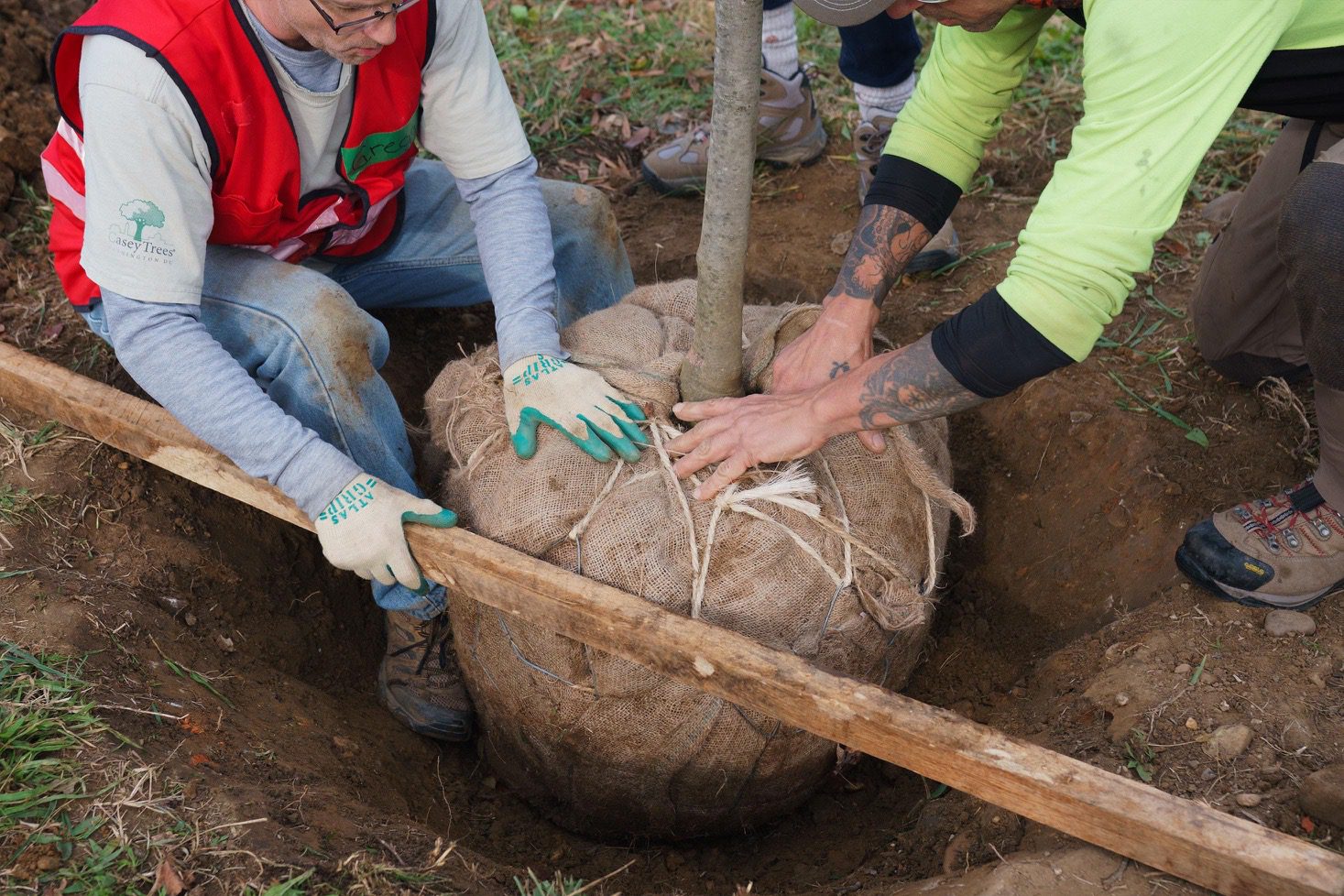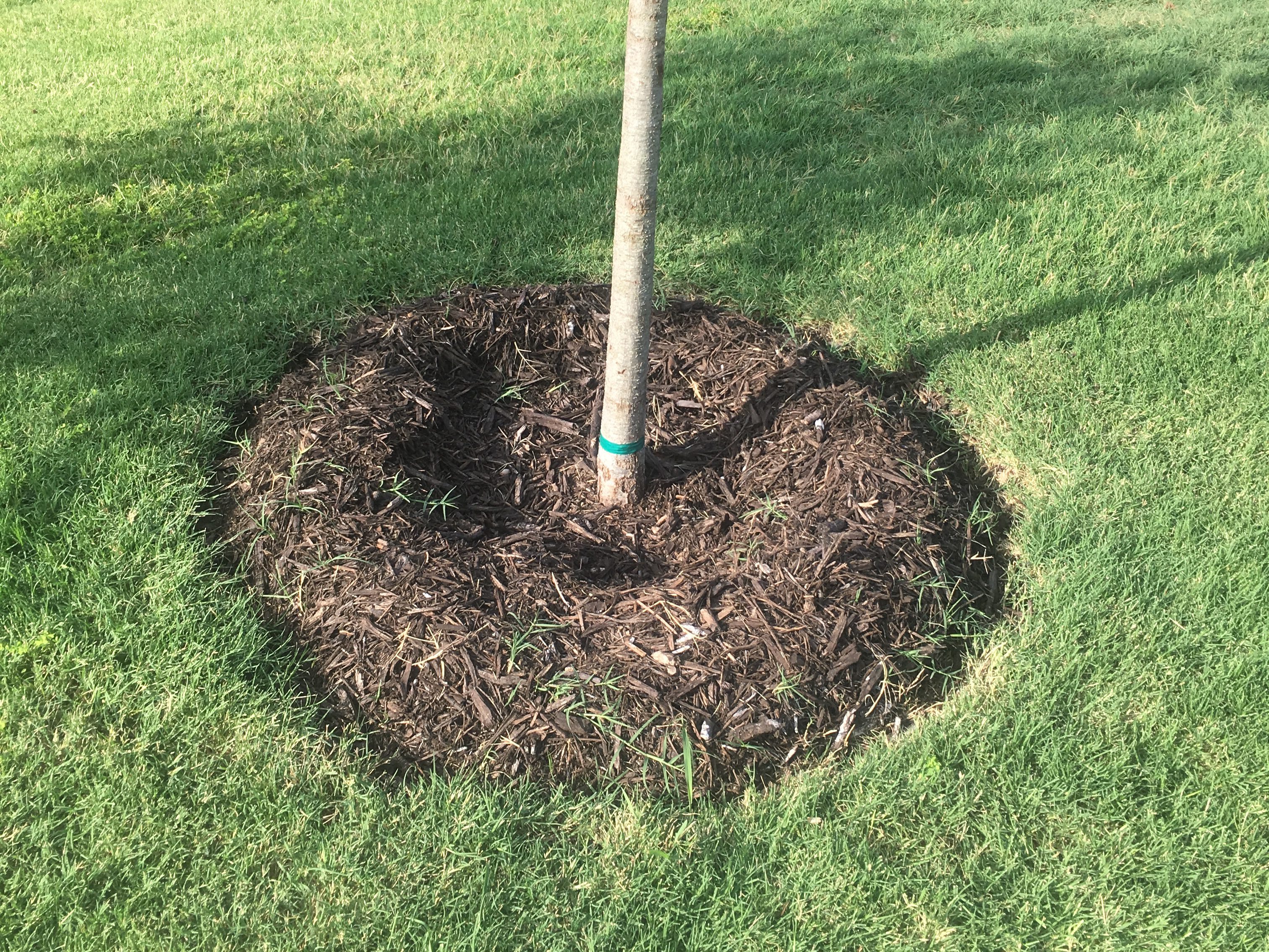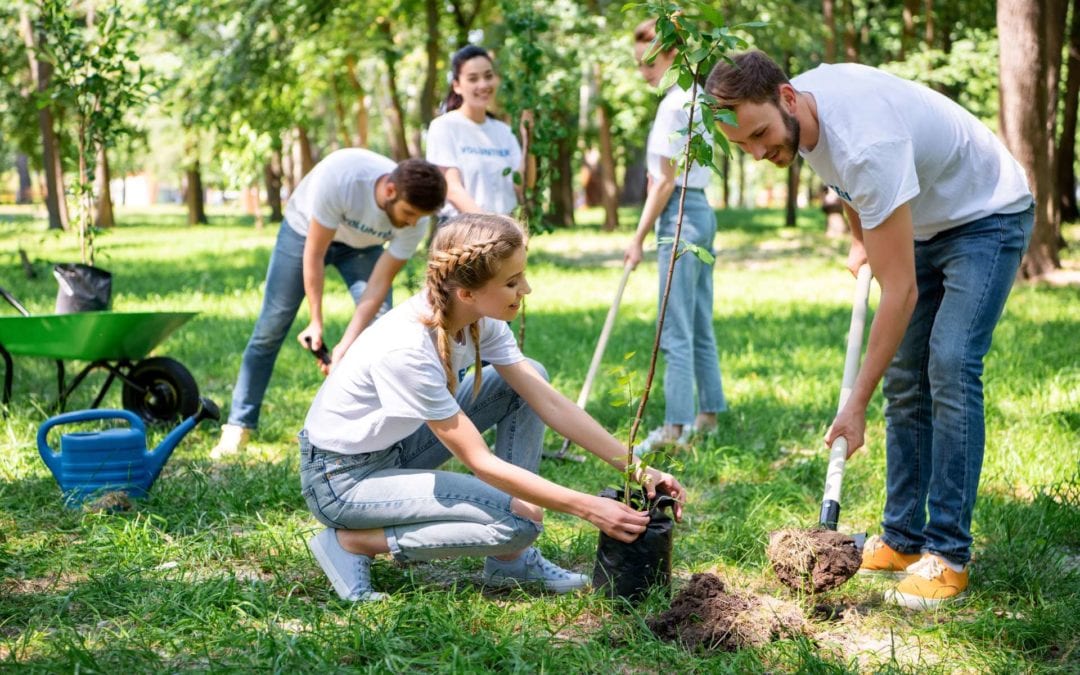Improper planting of a tree or shrub is the number one reason they die! Improper watering, and improper mulching are close seconds and thirds! Today, along with providing you a link to our Fall Tree and Shrub Planting Guide, we’re going to explain why planting a tree and shrub at the correct depth and width is so important (plus we’ll give you a few other helpful tips).
How Deep to Dig a Hole when Planting a Tree
When you planting a tree, dig a hole only as deep as the rootball of your tree. The top of the rootball should be level with the surrounding soil when the tree is placed into the hole.
Here’s the reason: A tree will settle into the soil over the years. The deeper you dig, the looser the soil is in the hole. The looser the soil, the more a tree gets settled down into the soil. The deeper a tree settles into the soil, the more likely it’s root collar will get buried. When a tree’s root collar gets buried, roots struggle to get adequate oxygen. When the roots don’t get oxygen, the entire tree starts to struggle, and the struggle can end in death. Follow? So basically, you should plant your tree at the exact same depth it has been growing in the container.

Using a level or straight board like the one pictured can help make sure your rootball of your newly planted tree is level with the surrounding soil
How Wide to Dig a Hole when Planting a Tree
When planting a tree, plan on digging a hole at least twice the width of the tree’s rootball.
Here’s the reason: Contrary to what you may think, most tree roots run more horizontal than vertical and they are somewhat shallow as opposed to deep. As a matter of fact, about 80% of a tree’s root system lies within the top 18 inches of soil. So by digging a hole twice as wide when planting a tree, you loosen the soil in the area that the roots will be growing into, allowing for faster and easier access to get established.
Mulching and Watering Newly Planted Trees
As mentioned at the beginning of the blog, planting a tree improperly is the number one cause of tree death, but mulching improperly and watering improperly are number 2 and 3. So here are a few extra tips to remember this fall when planting a tree.
1. Mulching. While mulching your newly planted tree is highly recommend, you should NEVER place mulch up against the trunk of a tree. Apply your mulch around your tree in a doughnut shaped berm rather than up against the tree in a volcano form. This mulch berm will also help with watering your newly planted tree correctly.
Mulch piled up against the side of the trunk can:
- cause moisture to get trapped against the trunk. The tissue of a trunk is not designed to be exposed to constant moisture. This could result in root rot and the possible demise of the entire tree.
- cause secondary roots to grow upwards where they can get damaged by sun, frost, and even start to strangle your tree, again, ending in your tree’s demise.

See the doughnut shape here with the mulch? No volcanoes! In this picture, you can see how the berm can easily be filled with water for a good root soak.
2. Watering. Newly planted trees will definitely need regular watering to get established. Lucky for us, planting trees in fall (the best time to plant in San Antonio) offers more chances of natural water from rainfall along with less evaporation due to cooler temperatures.
- Plan to water your newly planted tree once a week with a slow, trickling flow of water for about an hour. Adjust this schedule around weather: less water when adequate rain is available, and more water during times of extended drought.
- The doughnut-shaped mulch berm allows for easy, deep, efficient watering without losing water to runoff.
For our full tree and shrub planting guide with illustration, see the link.
~The Happy Gardener, Lisa Mulroy


Do you have or may I order a “AUTUM BLAZE MAPLE TREE” (about 7 to 8 feet tall) for backyard landscaping here in SAN ANTONIO. Your response will be appreciated. Thanks
Marv Sasser, ph 850-276-0565
Hi Marv,
Sorry for the delay in response. Our Bandera location currently has 5 gallon Autumn Blaze maple tree. It is about 5′-6′ tall. Please call store to place a hold on it for pick up.
Do you have services that have people come out to plant the trees for me? Thank you!
HI there,
Both locations offer delivery and planting services for trees purchased from Rainbow Gardens. Just call the store and our employees can set it up for you.
I am interested in a Monterey oak or Red Oak tree to be planted in my front yard.
can you help me ?
Hi Jane,
Rainbow Gardens would love to help you out with your tree planting. You will just need to visit the location you prefer to shop at (Bandera Rd. or Thousand Oaks Dr.) and pick out your tree, and schedule a time for delivery and planting services. Please see our locations page on our website at this link for store addresses and phone numbers.
Do you sell Bing Cherry trees? If San Antonio is Zone 8b, I guess I can try to plant cherry trees. They are my ultimate favorite fruit.
Hi Maria,
No Bing cherries, but this year we have brought in the Stella cherry and for our area it is the one true cherry that produces well in our region. This is the first year we’ve been able to get them! Super exciting.
Is April too late to plant a tree in San Antonio? Also, I have a smaller backyard… do you have any tree recommendations? something drought tolerant and low maintenance .
Hi Rachel,
While it is best to plant your trees in fall in San Antonio, you can still plant a tree in April but I would try to do it as soon as possible. You amy need to offer your tree more supplemental irrigation to make sure it is able to survive its first summer here.
As far as recommendations, it depends on what you are looking for in a tree. Are you looking for shade or an ornamental variety?
I can give you some smaller variety of trees that are low water usage, but remember that ALL newly planted trees need to be watered well until they are established.
Texas Redbuds, Texan Mountain Laurel, Ornamental Pomegranate (medium water), Mexican Plum, Mexican Buckeye, Desert Willow. These are average up to 25′.
Please provide a little more info on what you are looking for in a tree in order to help further.
Do you sell fruit bearing pomegranate trees and pecan trees?
Hi Maria,
We sure do carry both fruit bearing pomegranate and pecan trees. We have multiple varieties of pecans. Please call the location you wish to visit if you are interested in specific varieties to see what they have in stock at that time.
Hello,
Just bought property and will like to grow a vegetable garden, but also interested in planting a variety of draws fruit trees out of container being we have lots of rocks. Like to know what can I buy now to bring home? What you have currently? Eager to get started now. This holds true for blueberries, raspberries and other varieties of berries. Hope to hear from you and happy you come highly recommended
Hi Hector,
You can grow a multitude of fresh herbs throughout the year, and seasonal veggies in both spring and fall. Summer veggie planting is difficult because of the heat, but I am attaching our veggie calendar so you can see the date ranges that suitable for each vegetable. Tropical fruit trees can be planted now, citrus, but you will need to make sure all plantings are sufficiently watered all throughout summer as it is difficult for roots to get established in the heat. It would be best if you could state what specific crops you are interested in as our nurseries have a vast supply and carry many different varieties; plus we have two locations so after honing in on which plants you are interested in you can then contact the location most convenient to you to verify stock. It’s just too large of a list to state all we currently have.
In general, we carry hardy fruit trees (apple, peach, plum, pomegranate, etc…), citrus, tropical fruit trees, grapes, nut trees, a multitude of berries, and tons of seasonal veggies (during spring and early fall).
Vegetable Calendar
Looking for 10 to 15 foot Platanus occidentalis – do you have any any this time
Sorry, we do not carry that variety. We have found it to be very disease prone (Anthracnos), so we tend to carry Mexican Sycamore.